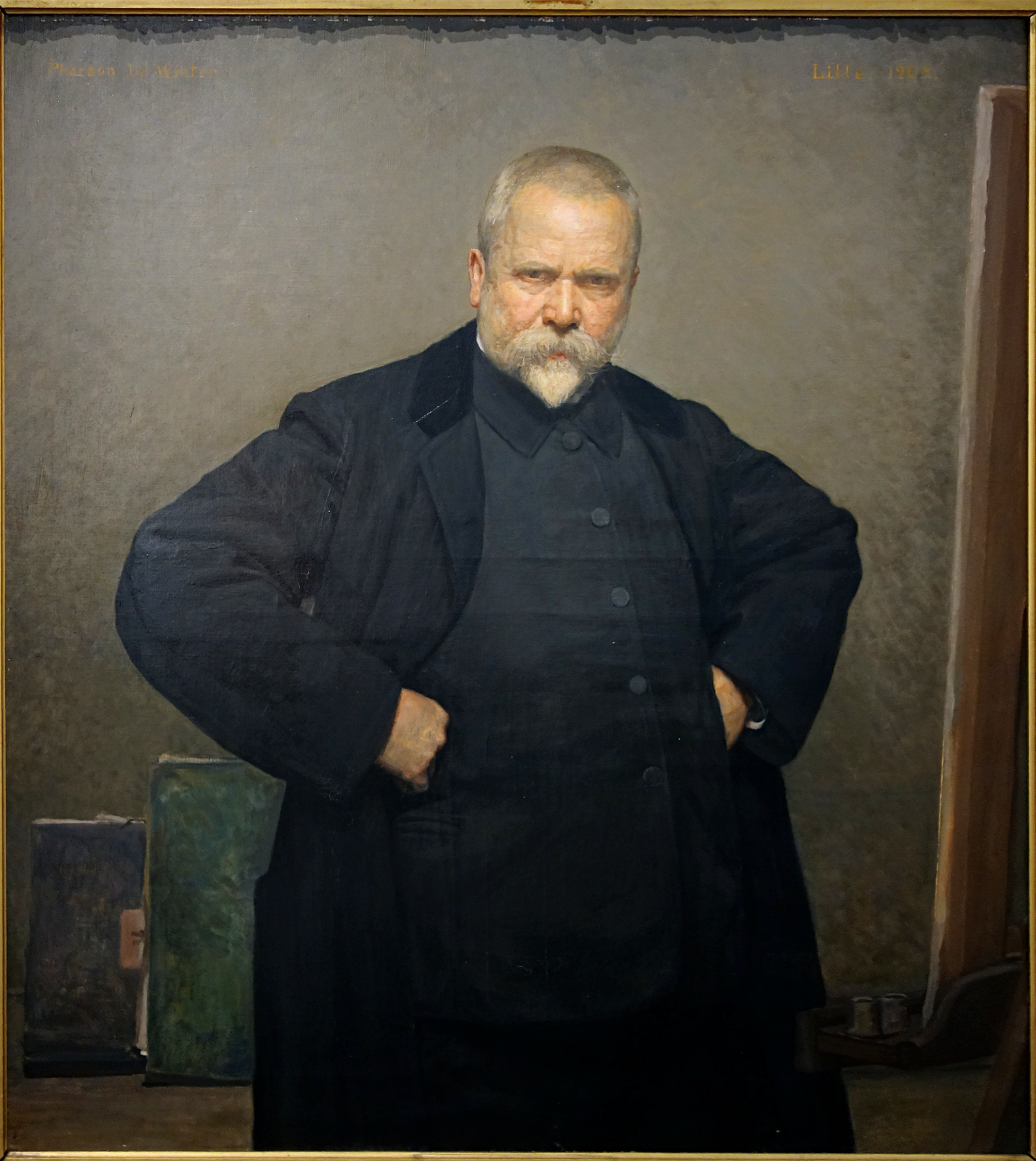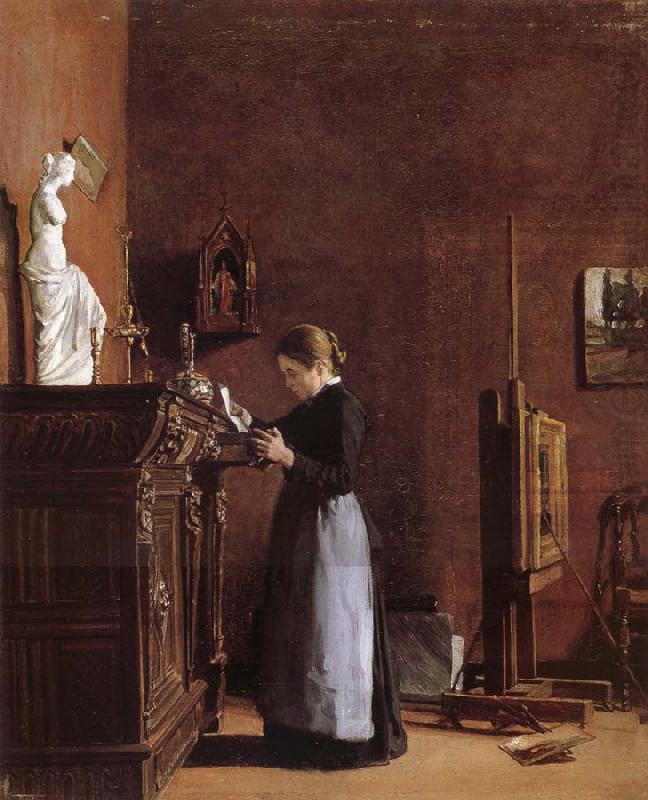Pharaon De Winter on:
[Wikipedia]
[Google]
[Amazon]
 Pharaon-Abdon-Léon de Winter (17 November 1849, Bailleul - 22 June 1924,
Pharaon-Abdon-Léon de Winter (17 November 1849, Bailleul - 22 June 1924,
 In 1877, he married one of his models, Angéline Charlet, but she died two years later, in childbirth. To help with his grief, he took an extended trip to Italy, but became ill and returned home. Once there, he threw himself into his work, producing large, impressive works for submission to all the salons. In 1881, he began an especially ambitious triptych; on the subject of the
In 1877, he married one of his models, Angéline Charlet, but she died two years later, in childbirth. To help with his grief, he took an extended trip to Italy, but became ill and returned home. Once there, he threw himself into his work, producing large, impressive works for submission to all the salons. In 1881, he began an especially ambitious triptych; on the subject of the
 The street where he grew up in Bailleul was named after him in 1930. The city of Lille also gave his name to a lane that connects two major streets near the Ècole's former location at the . The film, ''
The street where he grew up in Bailleul was named after him in 1930. The city of Lille also gave his name to a lane that connects two major streets near the Ècole's former location at the . The film, ''Pharaon de Winter
@ AllMusic
"De Vlaamse ziel in de Franse schilderkunst Pharaon de Winter (1849-1924)
a biography by Joost de Geest; summary by Jacques Fermaud, @ the ''Digitale Bibliotheek voor de Nederlandse letteren''
"Exposition Pharaon de Winter"
services culture & communication de la ville de Wambrechies, 2009. Exhibition catalog with biography and works. * Zéphyr de Winter, ''Pharaon de Winter. Sa vie - Son enseignement - Son oeuvre. 1849 -1924'', Librairie René Giard, Leleu 1926
 Pharaon-Abdon-Léon de Winter (17 November 1849, Bailleul - 22 June 1924,
Pharaon-Abdon-Léon de Winter (17 November 1849, Bailleul - 22 June 1924, Lille
Lille ( , ; nl, Rijsel ; pcd, Lile; vls, Rysel) is a city in the northern part of France, in French Flanders. On the river Deûle, near France's border with Belgium, it is the capital of the Hauts-de-France Regions of France, region, the Pref ...
) was a French painter; primarily of genre scenes.
Biography
He was the third of twelve children born to the family of a clog-maker, who gave them all literary names, such as Zénon, Odon, Ursmar, and Clovis. He displayed some early skill for drawing so, at the age of eleven, he was allowed to take lessons from an amateur local artist. In 1861, he left Bailleul to stay with an aunt in Bruges and work at her hotel. There, he attracted the attention of a professional artist named Henri-Julien de Stoop (1827-1864) and began learning art in earnest. Upon returning to France, in 1869, he enrolled at the and improved his skills, studying withAlphonse Colas
Alphonse-Victor Colas (25 September 1818, Lille - 11 July 1887, Lille) was a French painter and art teacher. He specialized in portraits and religious art.
Life and work
He was the fifth of seven children born to Jean-Joseph Colas (1779–185 ...
. In 1872, he moved to Paris, entered the École des Beaux-Arts, and worked in the studios of Alexandre Cabanel. He was also a frequent visitor to the workshops of Jean-Baptiste Carpeaux and Pierre Puvis de Chavannes
Pierre Puvis de Chavannes (14 December 1824 – 24 October 1898) was a French people, French Painting, painter known for his mural painting, who came to be known as "the painter for France". He became the co-founder and president of the Soci ...
. His first exhibit at the Salon
Salon may refer to:
Common meanings
* Beauty salon, a venue for cosmetic treatments
* French term for a drawing room, an architectural space in a home
* Salon (gathering), a meeting for learning or enjoyment
Arts and entertainment
* Salon (P ...
came in 1875. His style was heavily influenced by his friend and mentor, Jules Breton.
 In 1877, he married one of his models, Angéline Charlet, but she died two years later, in childbirth. To help with his grief, he took an extended trip to Italy, but became ill and returned home. Once there, he threw himself into his work, producing large, impressive works for submission to all the salons. In 1881, he began an especially ambitious triptych; on the subject of the
In 1877, he married one of his models, Angéline Charlet, but she died two years later, in childbirth. To help with his grief, he took an extended trip to Italy, but became ill and returned home. Once there, he threw himself into his work, producing large, impressive works for submission to all the salons. In 1881, he began an especially ambitious triptych; on the subject of the Redemption
Redemption may refer to:
Religion
* Redemption (theology), an element of salvation to express deliverance from sin
* Redemptive suffering, a Roman Catholic belief that suffering can partially remit punishment for sins if offered to Jesus
* Pi ...
. During this work, he became especially attracted to a model named Julia Marie Fagoo, the daughter of a farmer; painting a series of small genre scenes with her.
Later career and legacy
His work eventually attracted notice. In 1884, one of his works, "At the Dispensary", was reproduced in '' Le Monde illustré'' and issued as alithograph
Lithography () is a planographic method of printing originally based on the immiscibility of oil and water. The printing is from a stone (lithographic limestone) or a metal plate with a smooth surface. It was invented in 1796 by the German a ...
. In 1887, his former teacher, Colas, died and he was named the new Director of the drawing and painting courses at the École. For the first time in his life, he had a steady income so, in 1889, he married Julia. They had two children: a son, Zéphyr, born in 1891, and a daughter, Rosa, born in 1901.
Many of his students at the École won awards and became well known, including , , , , Auguste Herbin, Émile Ancelet and . In 1902, a dispute with the École, which involved a reduction in teaching hours, led him to resign and start his own school, under the patronage of Carolus-Duran
Charles Auguste Émile Durand, known as Carolus-Duran (Lille 4 July 1837 – 17 February 1917 Paris), was a French painter and art instructor.
He is noted for his stylish depictions of members of high society in Third Republic France.
Biograph ...
. Financial difficulties ensued, however, and he accepted an offer to return to his old position in 1905. Two years later, a major retrospective of his work was held in Roubaix.
He began having eye problems in 1912. They worsened after the start of World War I, and he underwent six operations during the German occupation
German-occupied Europe refers to the sovereign countries of Europe which were wholly or partly occupied and civil-occupied (including puppet governments) by the military forces and the government of Nazi Germany at various times between 1939 an ...
. To add to the misery, Zéphyr was taken as a war prisoner the day before he was due to be discharged. Then, in 1918, he learned that a German assault had destroyed Bailleul, including his parents' home and his original workshop, which he had been planning to turn into a small museum. About one-fifth of his total artistic output was lost. After the war, he continued to teach, but could no longer paint. By 1922, his condition was causing so much pain, he had to give up teaching as well. He died two years later.
 The street where he grew up in Bailleul was named after him in 1930. The city of Lille also gave his name to a lane that connects two major streets near the Ècole's former location at the . The film, ''
The street where he grew up in Bailleul was named after him in 1930. The city of Lille also gave his name to a lane that connects two major streets near the Ècole's former location at the . The film, ''Humanité
''Humanité'' (french: L'humanité) is a 1999 film directed by Bruno Dumont. It tells the story of a withdrawn police lieutenant investigating a rape and murder of a schoolgirl in rural France, his slow enquiries interspersed with everyday scenes ...
'', directed by Bruno Dumont
Bruno Dumont (; born 14 March 1958) is a French film director and screenwriter. To date, he has directed ten feature films, all of which border somewhere between realistic drama and the avant-garde. His films have won several awards at the Canne ...
, follows an alleged descendant of the painter, a police lieutenant in Bailleul. A passage from the film shows the protagonist lending a portrait of him to a museum in his region for a temporary exhibition. "Pharaon de Winter" is also the name of a French indie pop musical group that released their first album in 2015.@ AllMusic
References
Other sources
"De Vlaamse ziel in de Franse schilderkunst Pharaon de Winter (1849-1924)
a biography by Joost de Geest; summary by Jacques Fermaud, @ the ''Digitale Bibliotheek voor de Nederlandse letteren''
"Exposition Pharaon de Winter"
services culture & communication de la ville de Wambrechies, 2009. Exhibition catalog with biography and works. * Zéphyr de Winter, ''Pharaon de Winter. Sa vie - Son enseignement - Son oeuvre. 1849 -1924'', Librairie René Giard, Leleu 1926
External links
{{DEFAULTSORT:Winter, Pharaon de 1849 births 1924 deaths 19th-century French painters French genre painters French portrait painters French art directors People from Bailleul, Nord 20th-century French painters